Hole in the Clouds
Jan 10, 2010
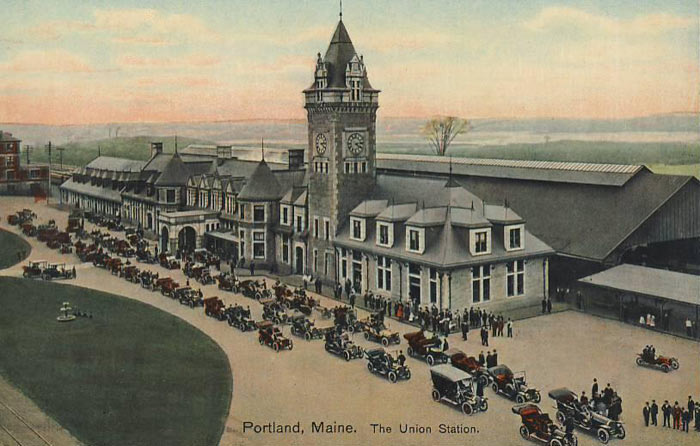

The Grand Trunk Line went bankrupt in 1920. Cost overruns on its expansion to the West Coast stressed the company, and its route planning out west proved unfortunate, too far north to compete with the fledgling Canadian National Railroad, which eventually absorbed it. The Grand Trunk's U.S. lines were assigned to a holding company that used the Grand Trunk name, but they too declined and faded in the mid-twentieth century along with the railroad industry in general.
The Grand Trunk station in Portland, on India Street near the waterfront, was demolished in 1948. These pictures actually show a different Portland train station, Union Station on Congress Street near St. John Street, which handled southbound passengers and freight. Union Station opened in 1911 and was demolished in the1960s to make way for the I-295 highway.
Portland lost an elegant building that day--the current Amtrak station is basically just a corner of the bus station lobby--but by all accounts, the destruction awakened people to the importance of historic preservation. And though it couldn't have been foreseen in the 1960s, when urban renewal was thought to lead to future glory for America's cities, Portland's old buildings and cobblestone streets have turned out to be what saved this town--people have learned to make money off of "quaint."
Portland
vintage
Maine
railroad
demolition
Union Station
train
Nov 13, 2011
 A couple of weeks ago, on Philly Photo Day, Ashley Cabrera shot this scene of a train headed eastward above Market Street in West Philly. Some of the Love Letter rooftop murals can be glimpsed off to the right, and of course that's the Center City skyline straight ahead.
A couple of weeks ago, on Philly Photo Day, Ashley Cabrera shot this scene of a train headed eastward above Market Street in West Philly. Some of the Love Letter rooftop murals can be glimpsed off to the right, and of course that's the Center City skyline straight ahead.
cityscape
birdseye
streetscape
train
Love Letter murals
West Philadelphia
(Image credit: Ashley Cabrera)
Sep 22, 2013
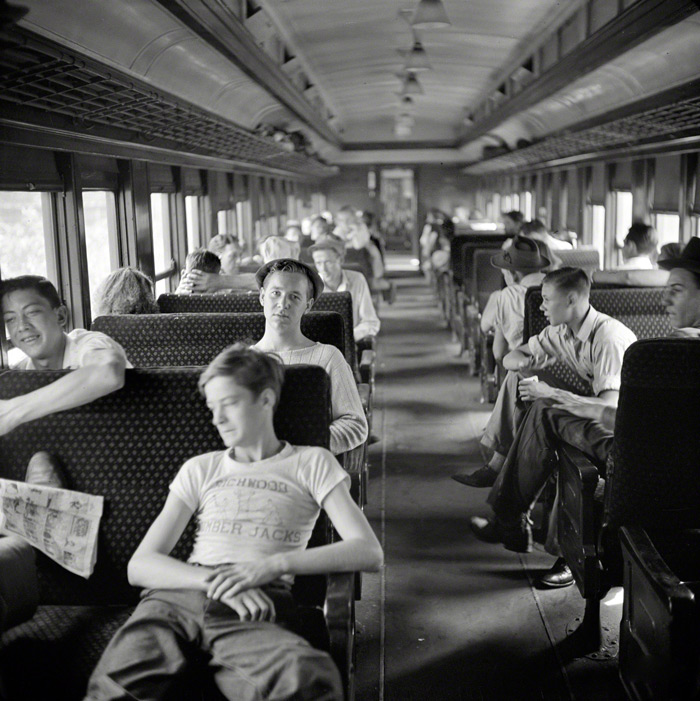 By the summer of 1942, the American war effort was in such high gear that many agricultural regions were experiencing a severe labor shortage. All the young men were serving in the military, almost everybody else was working in war industries, and nobody was left to pick the nation's peas and beans.
By the summer of 1942, the American war effort was in such high gear that many agricultural regions were experiencing a severe labor shortage. All the young men were serving in the military, almost everybody else was working in war industries, and nobody was left to pick the nation's peas and beans.
As part of a program designated "Food for Victory," this specially chartered train brought more than three hundred high school boys and girls from the coal-mining town of Richwood, West Virginia, to the farming district around Batavia in upstate New York, where they would pick peaches, apples, tomatoes, and other crops. The program also brought in teenagers from other non-farming places, including Brooklyn, New York, where one of the high schoolers who signed on to help with the harvest upstate was the young Helen Ruskin, Norman's mother.
New York
West Virginia
Helen
train
World War II
high school
1942
youth
Richwood
(Image credit: John Collier via Shorpy)
Feb 9, 2014
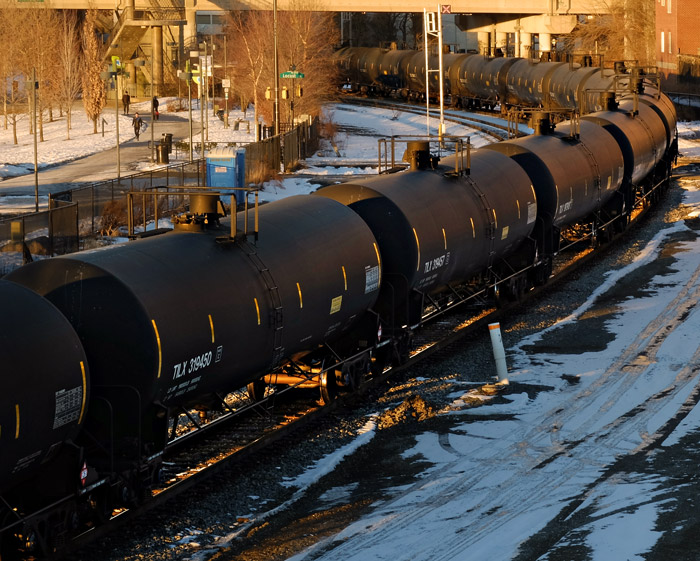 Sadly, what this train is hauling is the kind of stuff that keeps us warm. We have to do something about this.
Sadly, what this train is hauling is the kind of stuff that keeps us warm. We have to do something about this.
train
Schuylkill River
Philly
Schuylkill Banks
Locust Street
(Image credit: Little Fuji)
Apr 28, 2014
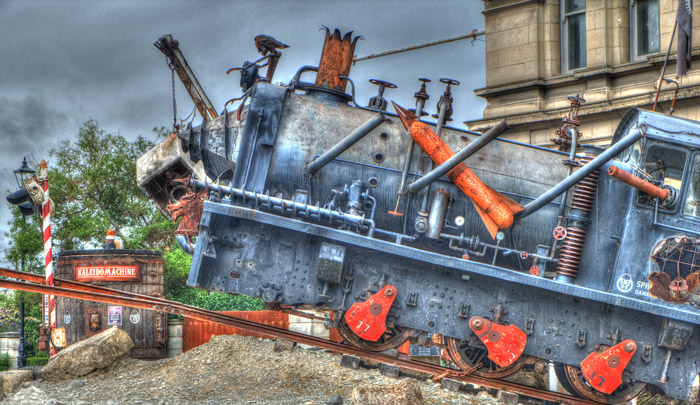 Three hours south of Christchurch on the east coast of New Zealand's South Island is Oamaru, one of the country's oldest cities and briefly–back in the 1870s–one of its wealthiest and fastest growing.
Three hours south of Christchurch on the east coast of New Zealand's South Island is Oamaru, one of the country's oldest cities and briefly–back in the 1870s–one of its wealthiest and fastest growing.
There was a halfway decent harbor for a port to serve the thriving agricultural region, especially after introduction of refrigerated transport for meat. High-quality limestone for building was locally plentiful. A 50-km-long aqueduct was constructed to slake the thirst of the booming little city and irrigate surrounding farmland with fresh mountain water. Industry emerged, lapping up the new water supply. The city built an opera house, an athaeneum, and a large and ornate public garden.
By the 1880s, when economic depression hit hard, Oamaru was said to be "the best built and most mortgaged town in Australasia." The aqueduct went bankrupt, the port closed, industry languished, and construction stopped for more than a hundred years.
What finally saved Oamaru was steampunk, the style of art and/or life that emerged from the punk rock era but is rooted in Victorian-era visions of a fantastic feature: think Jules Verne and H. G. Wells. Steampunk science fiction is inspired by nineteenth-century steam-powered technology and decorative arts, ratcheted up by twenty-first-century irreverence and intensity.
Oamaru's intact nineteenth-century downtown–intact because nobody since the nineteenth century had thought the place worth a dime of investment–created an ideal backdrop for steampunk festivals, steampunk artists' studios, steampunk shopping, and eventually steampunk tourism.
(Oamaru also has penguins, more of which soon. Watch this space.)

New Zealand
train
Oamaru
steampunk
(Image credit: Little Fuji)
Nov 7, 2014
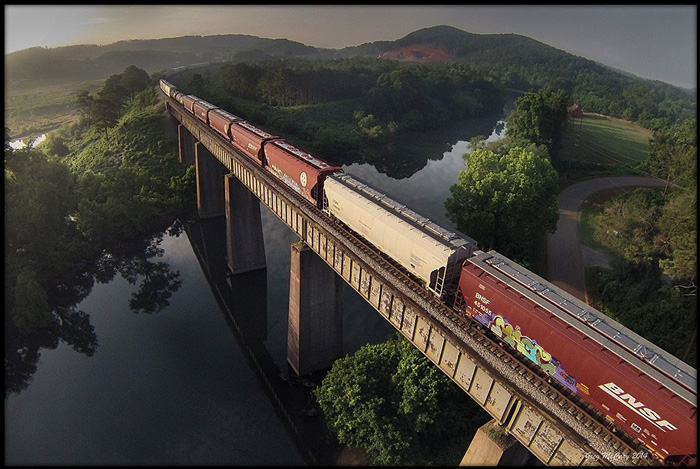 All the cool kidz nowadays–all the cool kidz who have a little too much money–or is too much money one of the requirements for cool kidz status?–anyways, what they're playing with these days is the latest and greatest in technology for drone photography.
All the cool kidz nowadays–all the cool kidz who have a little too much money–or is too much money one of the requirements for cool kidz status?–anyways, what they're playing with these days is the latest and greatest in technology for drone photography.
Little plastic remote-controlled flying saucers carry cameras aloft and point the lenses back down at us. Sometimes the things crash–for example, onto the balcony of an apartment on a high floor of a New York skyscraper–but sometimes they capture astonishing views of life here on the surface of earth.
To get the shot above, Greg McCary flew a drone up over the hills and rivers of Bartow County, Georgia, northwest of Atlanta. Below, Mauricio Lima's venture into drone photography attracted the attention of a wary neighbor.
birdseye view
railroad
train
bridge
Bartow County
drone
Cartersville
trestle
Mauricio Lima)
(Image credits: Greg McCary
Feb 9, 2016
 The 170th birthday of Claude Monet in November 2011 was marked by, among other festivities, a Photoshop competition sponsored by FreakingNews.com. The challenge was to Photoshop a composite image introducing modern elements into a Monet painting.
The 170th birthday of Claude Monet in November 2011 was marked by, among other festivities, a Photoshop competition sponsored by FreakingNews.com. The challenge was to Photoshop a composite image introducing modern elements into a Monet painting.
The winning entry, shown above, was submitted by somebody who logged into the competition as azwoodbox. That's a train à grande vitesse, imitating Monet's 1875 train below.
winter
train
snow
photoshop
Impressionism
Claude Monet
bullet train
(Photoshopped image by azwoodbox; painting by Claude Monet.










